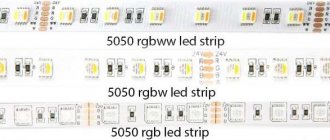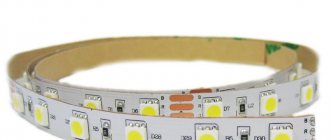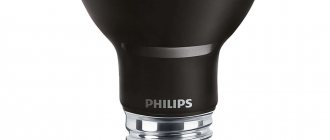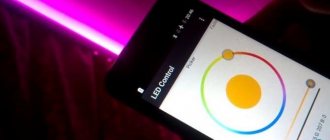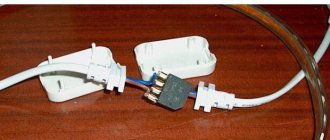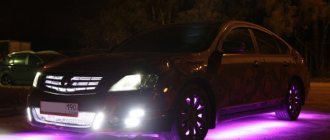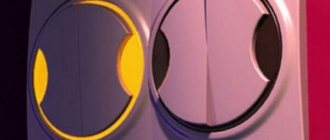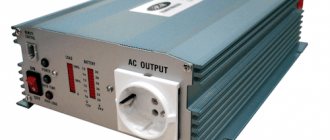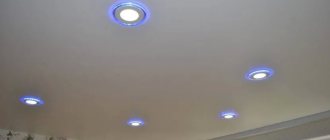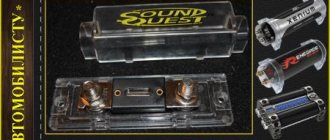What is LED strip
An LED strip is a flexible light source assembled on the basis of a flexible printed circuit board, on one side of which LEDs and auxiliary radio components are located.
Thanks to the use of ultra-bright types of SMD LEDs, LED strips have high brightness and at the same time low energy consumption. Their flexible base allows them to be used in various design solutions for decoration or additional lighting, and sometimes as the main lighting of a room.
Operating principle of network LED strip
Typically LEDs do not operate on AC circuits. They are used with drivers or power supplies. This applies both to individual elements and to structures assembled on a board, tape, or other methods. But there is an LED strip on sale that can be connected directly to a 220 V AC network.
In reality, things are not quite like that. The circuit does not have step-down transformers or filter smoothing capacitors. The design operates without a power supply in its classical sense; its functions are performed by limiting resistors and a rectifying diode bridge.
Let's see what the tape consists of:
- SMD LEDs;
- current limiting resistors;
- flexible printed circuit board;
- self-adhesive base;
- full-wave rectifier;
- plug for connecting to a socket.
On the one hand, such a design leads to a reduction in cost and simplification of the design, on the other hand, it limits the possibilities of application in residential premises. But we will talk about this later, in the section on advantages and disadvantages.
What types of LED strips are there?
LED strips can be divided into different types according to many different parameters, and the criteria for division can be the design features of LED strips and the technical characteristics of installed SMD LEDs.
According to the color rendition of the installed LEDs: - monochrome LED strip (consists of LEDs of the same color); — RGB LED strip (made from RGB LEDs, where each LED contains three LEDs of different colors, red, green and blue, in one housing).
In terms of security of the LED strip: - open, non-sealed LED strip IP20 and IP33 (used indoors); — silicone-coated protected LED strip with protection degree IP54 and IP65 (used in places where the LED strip can come into contact with water, including outdoors); — completely enclosed LED strip with degree of protection IP67, IP68 (for use outdoors without restrictions, in swimming pools).
LED strip design
LED strips are made on the basis of a long flexible printed circuit board, the width of which can be from 8 mm to 20 mm. We will consider the design of the board itself using the example of the most common LED strip with a 12 V power supply.
A long LED strip consists of small segments, separately assembled sections of the board. Each such section contains 3 SMD LEDs with a current-limiting resistor. All elements are connected in series. Each LED requires a voltage of 3.2 V. When connecting the entire assembly of LEDs in series, 9.6 V is required. And so that such an assembly can be written from a voltage of 12 V, a limiting resistor is installed in series in the power circuit, the resistance of which is selected based on the established type of SMD LEDs for which power is required certain current.
The entire length of the LED strip consists of parallel-connected individual sections of LED assemblies. They are all the same and are powered from the same source.
LED strips with SMD 5050 LEDs are also connected in separate assemblies of three LEDs. Since these LEDs have three separately connected diodes in one housing, three tracks and three resistors are needed to connect them.
RGB LED strips also consist of separate assemblies of three LEDs, but in them each color channel is connected separately. It turns out that such an LED strip has four tracks at once.
LED strip supply voltage
The most common are LED strips with a supply voltage of 12 V, less commonly you can find LED strips with 24 V. Power supplies and LED drivers are used to power LED strips. The input of the LED driver is supplied with voltage from a 220 V network, and the output produces a stabilized voltage of 12 V or 24 V. The voltage must be stabilized and no more than the value indicated in the characteristics of the connected LED strip. If the voltage is higher, the LED strip may fail due to higher current flow, strong heating and, as a result, the LEDs burn out.
If the power supply produces less voltage than required, the LED strip will glow dimly or there may not be enough voltage to turn on the LEDs. For example, if you connect an LED strip designed for a 24 V supply voltage to a 12 V LED driver, it simply will not turn on.
There are LED strips that do not require a power supply and are connected directly to a 220 V network. Such strips have a high degree of protection from dust and moisture, as they are placed inside a PVC tube.
Advantages and disadvantages compared to 12 V tape
LED strips for connection to a 220 V power supply have the following advantages:
- Easy to connect. Unlike 12 V models, they do not need an expensive power supply, just an outlet. Fewer elements in the circuit means more reliability.
- Due to the previous point, the cost of the finished structure is reduced.
Otherwise, the advantages are the same as those of low-voltage analogues. But there are two significant drawbacks:
- 220 volts is a high voltage that is dangerous for humans; you should not use such tape in a swimming pool.
- Due to the pulsation of the 220 V light flux, the tape cannot be used as a lighting source.
In addition, if there is a surge or increased voltage in the 220 V supply network, the tape, unlike a low-voltage one, will quickly fail.
LED strip power
It is important to know the power of the LED strip, because the choice of power source depends on it. The power depends on the LEDs used and the density of their placement. The most popular LED strips with the following LEDs: SMD 3528, SMD 5050, SMD 5630, SMD 5730.
The LED density cannot be any. It is determined by the number of LEDs per 1 m of LED strip, i.e. per linear meter. The most widely used are LED strips with 30, 60 and 120 LEDs per 1 m. The density of LEDs also affects the uniformity of the luminous flux. To illuminate something, LED strips with a density of 30 to 60 LEDs are used. For uniform illumination, it is better to take LED strips with a density of LEDs of at least 60 or 120 pieces per meter.
For the most common types of LED strips, tables of power consumption per meter of LED strip have been compiled, depending on the type of LEDs installed and their placement density.
Power table of 1 m LED strip with different numbers of SMD LEDs
What cable channels for LED strip are there and their features
Cable channels differ in the material of manufacture and type of installation. There is a difference in the appearance of the screen. An overhead cable channel is a U-shaped structure that is attached using special glue or self-tapping screws. It has protection from rain and ultraviolet rays.
The pendant type is used for installing designer lamps. This option is similar in form to the invoice.
Types of profiles by area of application
Depending on where they are used, they can be divided into several subgroups. Among them are:
- invoices;
- built-in;
- mortise;
- hanging;
- corner.
The latter is needed in order to fix the lamp bending along the surface. The light flux here is directed at an angle of 45 degrees.
Types of profiles based on material of manufacture
The choice here is not that great. Boxes are produced from aluminum or plastic. There are several nuances. Only high-quality and wear-resistant plastic can be used. It should not deform when heated.
If the lamp is very bright, then it is better not to choose a plastic box. It is not able to remove heat from glowing diodes. This profile is usually used to illuminate work display cases. Aluminum boxes do not have such disadvantages.
Types of screens
The screen is needed to diffuse the light. They serve to seal the light source. If necessary, you can remove and replace them. Screens can be matte or transparent. The former reduce the luminous flux by about 5%. The second - by 30%. Do you want to create a directional light stream? Then use a screen with a lens. Companies today produce various screens. Finding a suitable option will not be difficult.
LED strip brightness
The brightness of an LED strip, as well as its power, is determined by the type of LEDs installed and their density on the strip. Those. Knowing the brightness of one LED, it will be easy to calculate the brightness of the entire strip. In theory, everything is simple, but in practice, LEDs may turn out to be of poor quality.
LEDs can be divided into branded high-quality ones and cheap Chinese ones, and which ones are installed on the LED strip sometimes one can only guess. When purchasing branded LED strips, you can most likely count on installed high-quality SMD LEDs.
Branded and cheap Chinese LEDs are practically no different in appearance, but their characteristics can differ greatly. Chinese SMD LEDs can have characteristics two times lower, which will naturally affect the brightness of the strip. The tables below will show the parameters for white LEDs. For warm white and cool white LEDs, the luminous flux data may be lower.
Brightness and power of cheap popular SMD LEDs
Brightness and power of proprietary SMD LEDs
But even knowing the exact parameters of the LEDs installed in the LED strip, the luminous flux can be calculated approximately, since the tabulated luminous flux will be issued only at the rated supply voltage, which may differ slightly.
Features of powerful LED strips
Any LED strip, including its brightest modification, is a strip-board made of flexible material with a given number of LED elements soldered on one side. Depending on the purpose, the number of diodes, the size of their crystals and the density per meter of length can vary significantly. At the same time, they are powered by a 12-volt DC source, so for operation they require the connection of additional equipment - a converter, transformer, as well as a control unit (controller, dimmer).
Among the main features of the brightest LED strips are:
- Company manufacturer.
- Type of LEDs.
- Density.
- Glow color.
- Diffuser type.
The brand of the ice product largely influences such important operational parameters as service life, glow stability and compliance with the declared characteristics. The best models in the affordable price segment today are produced by Chinese, Korean and Japanese companies, while more expensive ones are produced by European and American companies. In addition, on the market you can find a large number of unknown brands offering products very cheaply, but the quality of such products is unlikely to be up to par and they will not last very long.
Ice crystals installed in LED strips can have different sizes - SMD 2835, 3538, 5050 and the brightest - size 5730. They all differ in the amount of luminous flux produced. For example, if the former produce about 24 Lm, then the latter produce at least 70 Lm.
The number of LED elements in a certain section of the strip is another important parameter characterizing the product. Crystals can be arranged in one or two rows. The more of them are placed per unit of tape segment, the higher the brightness and energy consumption. Therefore, the most powerful models require 24 V for power supply.
According to the light shade, the brightest, as well as ordinary, LED strips are divided into:
- Single color. This type of ice strips can only illuminate in a specific shade - in the spectrum segment corresponding to the manufacturer’s declared one - from 2700 to 6000 K, with the luminous flux of white light being considered the brightest. To give a characteristic shade, appropriate coloring of the initially transparent led element is applied.
- Tricolor. RGB modifications are based on crystals of three primary colors - blue, red and green. By combining them you can obtain any desired shade. Unlike the modifications described above, they are 3 times more expensive, but they make it possible to significantly diversify the color design of the lamp.
Another extremely important feature of the brightest LED strips is the type and material of the ice crystal diffuser. As a rule, this component is made of plastic that is completely transparent, either white or semi-matte. The most powerful modifications are made using the first type of optics; when using the second and third types, the lamp will lose up to 20% of its luminosity.
Note! It is quite difficult to professionally check the quality of the LED strip of the brightest modification, since you need to simultaneously take into account several technical factors that can only be determined by experts. However, there are several methods for the naked eye. Firstly, quality products even outwardly are distinguished by good execution - neatly wound bobbins, a branded adhesive backing, a certificate. Secondly, you can measure their brightness with a lux meter. Thirdly, the condition of the printed circuit board - the copper on them should be rolled, not sputtered.
Connecting LED strips
To connect the LED strip, you need a power source with the appropriate voltage. In this case, you need to pay special attention to the power of the selected power supply. The so-called driver for the LED strip should have a small power reserve, about 30% more. This does not apply only to LED strips connected directly to a 220 V network.
LED strips can be sold in small pieces and whole reels of 5 meters, and they are all connected in the same way, observing the polarity to power sources with suitable voltage and power.
The maximum length of one connected strip of an LED strip should not exceed 5 m. This is due to the voltage drop in the thin copper traces deposited on the strips. Not only will the last strip in the circuit not glow so brightly when connected in series, but the first strip in the circuit will overheat due to the increased current flowing through it. The only exception can be low-power LED strips, which sometimes connect up to 3 serials.
To increase the length of the LED strip to more than 5 m, the next strip must be connected in parallel to one power source. In this case, the power of the LED driver will have to be already calculated to connect several LED strips. This is not always convenient, because at the same time, the dimensions of the power supply also increase significantly with higher power, and to accommodate a long LED strip of several strips, it is better to use separate small LED drivers for each of them.
When connecting LED strips in parallel from one power source, the wires can be connected on both sides at once, i.e. at the beginning of the LED strip and at the end. This will relieve the tape tracks from high current and make the tape glow more uniform over the entire area.
If necessary, the length of the LED strip can be made arbitrary, either shorter or longer. LED strip of any length consists of individual segments, small LED assemblies. In a 12 V LED strip, such a segment consists of three LEDs and a resistor. And this is the minimum length of LED strip that can be cut and connected to a power source. For a 24 V strip, such a segment will consist of 6 LEDs, for a 220 V strip, 70 LEDs.
You only need to cut the LED strip in a special area, which is marked with scissors and exposed copper contacts. A cut in an arbitrary section of the tape will not disable it, but will only ruin one minimal segment, which will eventually have to be cut out.
To connect individual sections of LED strips into one large strip, it is necessary to connect the contacts of these strips, taking into account the polarity indicated on them. We connect plus to plus, minus to minus. Soldering is the ideal connection option, but many different connectors have been developed to simplify the process of joining LED strips and connecting them to the power supply. Their design is a snap-on product with contact pads and pressure pins. After assembling such a connector with an LED strip, its contacts are connected to the contact pads of the LED strip and it is fixed inside the connector.
Dimmers are used to adjust the brightness of LED strips. The dimmer can be an analog or digital device. Analog dimmers are assembled based on semiconductor elements and operate on the principle of limiting the current from the power source without changing the operating voltage. Digital dimmers for LED strips operate on the principle of pulse-width modulation of the supplied power.
The dimmer is installed in the power supply circuit of the LED strip, i.e. between the power side and the LED strip. When choosing a dimmer, you need to pay attention to the maximum adjustable current, which should be slightly greater than the maximum current consumption of the connected LED strip.
Multi-color RGB LED strips are connected through a special RGB controller, which can control each color of the strip individually. The length of one section of such a tape also cannot exceed 5 m. Two wires go to the controller from a 220 V network, and four wires go from the controller to the RGB tape, where one wire is common and three are intended for controlling red, green and blue LEDs.
Several RGB LED strips, the total length of which exceeds 5 m, are connected to the controller in parallel. If the controller power is not enough to connect several strips, the next RGB LED strip is connected through a so-called signal amplifier or simply a repeater. The RGB amplifier is connected to the RGB controller, the signal from which it duplicates at its output for connecting the next LED strip. Moreover, this amplifier is separately connected to its power supply and is also designed for a certain power.
Fastening LED strips
Almost all LED strips already have an adhesive backing to allow them to be attached to any smooth surface. To attach them, all that remains is to degrease the surface to which the LED strip will be attached, remove the protective film from the double-sided tape applied to the strip, and glue the tape to the surface. But here you immediately need to divide the LED strips into two groups according to power, up to 14 W/m and more than 14 W/m.
This division into two groups is associated with the heat generation of the LED strip and the need for additional cooling. LED strips with a power consumption of up to 14 W/m are able to dissipate heat in a natural way, i.e. Natural air cooling will be quite enough to prevent the LED strip from overheating during operation. Such tapes are simply glued to any surface.
LED strips with a power close to 14 W/m already require additional cooling and, at a minimum, should be glued to a surface with good heat transfer. Alternatively, you can make a backing from aluminum tape. At higher power, an aluminum profile will be required to mount the LED strips.
220 V LED strips are located inside a PVC tube and various brackets are usually used to attach them to the surface.
Why do you need a box for LED strip?
The main function of this design is to remove heat. Bright tapes can become quite hot during prolonged use. If you don’t want the LEDs to burn out quickly, then you should think about purchasing a high-quality box.
The profile is used to create beautiful lighting. This is especially important for creating advertising structures; they are used to decorate furniture. You can implement various design concepts, for example, by assembling various pieces. The box performs several other important functions.
- It increases the service life of the lighting source. The profile, made of special materials, acts as a heat sink.
- Using a box, you can protect the LEDs from mechanical damage.
- The light gets a softer shade that is pleasing to the eye. Frosted diffuse glass gives a special effect.
Advantages of using boxes
Do you want LED strips to last you as long as possible? In this case, you should use special boxes. They are lightweight and portable. In addition, you can avoid fire. The fact is that the profile will not allow severe overheating. Use bright ribbons without worrying about safety. You can choose a box that can transform the structure. Special glass gives a special glow.
How to choose LED strip
The choice of LED strip must begin with finding out its purpose and, based on this, select it based on known characteristics. For example, for outdoor use, an LED strip is required that can be connected into one long strip and that will be protected from the influence of weather conditions. A 220 V LED strip meets these requirements. It is placed inside a transparent plastic tube, which makes it protected from any influence of moisture and dust, can be connected into one long strip of up to 100 m and does not require a complex power supply. In fact, it connects directly to a 220 V network.
To illuminate a suspended ceiling, a low-power LED strip with a degree of protection IP20 is suitable, i.e. without any coating. Since this LED strip has a consumption of within 10 W/m, it can be mounted without an additional cooling system, gluing directly to the suspended ceiling. But, if you plan to use an LED strip as the main lighting, which immediately puts it in the category of power consumption of more than 14 W/m, its installation will require an aluminum profile, which will dissipate the excess heat generated.
For lighting in the bathroom, you will need an LED strip with moisture protection, which already corresponds to a degree of protection of at least IP54. Such strips have a silicone coating on the LED side, which acts as protection. When installing protected LED strips, it is also necessary to take into account the power consumption per meter of LED strip, and, if necessary, use an aluminum profile.
What are the colors of the ribbon glow?
If a seller claims that a certain LED strip is the brightest, this does not mean that you will get a backlight that shimmers with all the colors of the rainbow. Ultra-bright models are mostly single-color. They are well suited for highlighting individual areas and illuminating furniture, window or doorways. Basically, such models produce cold white light.
However, multi-color (RGB) tapes are also available. This is a good option for decorative lighting and original lighting design projects. The brightest light is the RGB LED strip with 5060 diodes (2-row with 120 diodes per meter).
As you can see, depending on the color of the glow, such sources can be used in different ways. This is important to understand before choosing the brightness of the LED strip and its color.
For multi-color models, you can adjust the intensity and color of the lighting using the remote control, and also turn on different effects: “snake”, “wave”, “slow decay”, etc. If you like a “warm” interior, you can turn on yellowish light, and if you want For something original, feel free to set bright red, bright blue or other non-standard backlight modes.
Advantages and disadvantages of LED strips
The main advantage of LED strips is the possibility of their use for the formation of complex decorative lighting and easy installation. The LED strip is made on a flexible base and can be easily shaped into different shapes.
The color of the LED strip can be almost any. There are some standard colors of monochrome LED strips and varieties of their shades, as well as multi-color LED strips that can change color. In addition, their brightness is quite easy to adjust.
An important advantage of LED strips is their service life and power consumption, which is several times less compared to other light sources. If all rules and recommendations for connection from the manufacturer are followed, they can work from 20 thousand hours to 50 thousand hours, and if the power consumption is forced to be reduced by 20% or 30% of the nominal value, their service life will increase even more.
The main disadvantage of LED strips is their strong sensitivity to overheating. This is due precisely to the LEDs themselves, which, when heated above 70 degrees Celsius, begin to degrade, which is manifested in a change in the spectrum of the emitted light and a decrease in brightness. This eventually causes the LED to burn out. That is why it is necessary to strictly adhere to all recommendations for installing LED strips and, if necessary, use an aluminum profile to dissipate heat.

